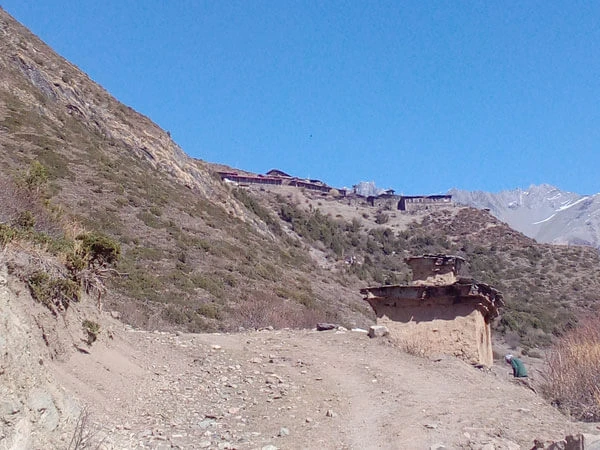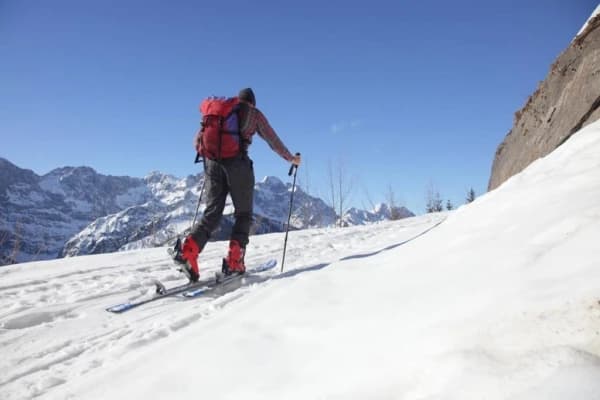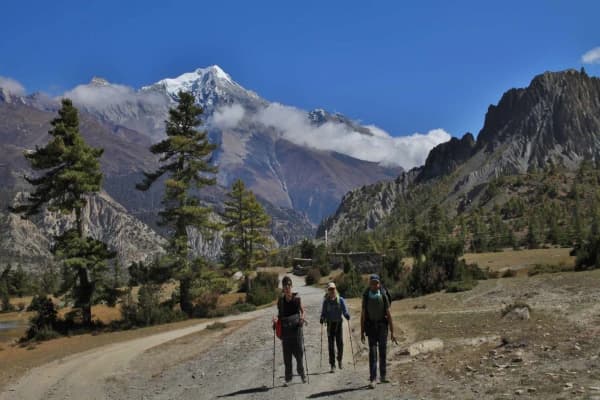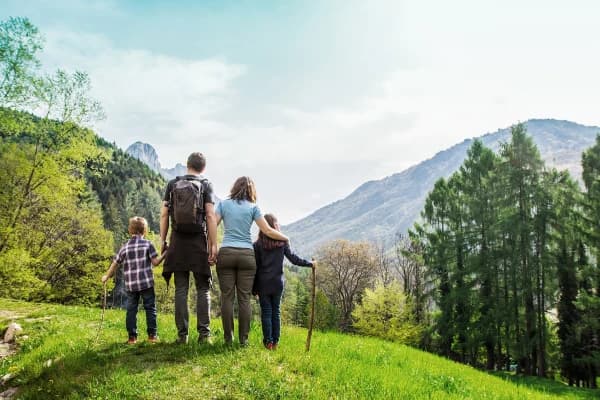Are you trying to avoid crowds during your trekking adventure and enjoy the natural beauty peacefully? We are here for you!
This off-the-beaten-path trekking guide to Nepal covers some of the country's lesser-known trails, which offer stunning views, rich culture, and an incredibly quiet experience. While routes like Everest Base Camp and Annapurna Circuit attract the majority of trekkers, Nepal also has some off-the-beaten-path gems that offer the same experience, but without the crowds.
If you are the type of traveler who craves solitude, unspoiled nature, and an intimate look at local life, then these off-the-beaten-path trails are the way to go.
Read on to learn about the 7 best less discovered trekking destinations in Nepal, where you can stroll through peaceful valleys, explore remote mountain towns, and get up close to the most pristine peaks in the Himalayas.
1. Nar Phu Valley Trek
Difficulty: Physically demanding, includes high passes and long trekking days
The Nar Phu Valley Trek is one of Nepal’s most remote and least-crowded adventures, tucked away in the northern reaches of the Annapurna region near the Tibetan border. Once restricted to outsiders until 2002, this hidden valley offers a rare glimpse into a world untouched by time.
As you journey through the ancient villages of Nar and Phu, you’ll be immersed in age-old Tibetan-influenced culture, where stone houses, prayer flags, and centuries-old monasteries reflect the region’s deep spiritual roots. The rugged trails reward trekkers with breathtaking views of Himlung Himal, Kangaru Peak, and the raw beauty of the Himalayan wilderness.
This is the perfect trek for you if you're seeking solitude and authenticity, this off-the-beaten-path trek combines dramatic mountain scenery with rich cultural encounters, a true Himalayan experience away from the crowds.
Highlights of the Trek:
- Explore the untouched valleys of Nar and Phu, where ancient Tibetan culture, stone-built villages, and timeless traditions still thrive.
- Look up at Himlung Himal and Kangaroo Peak rising dramatically above the rugged Himalayan landscape.
- Trek over the high Kang La and Thorong La passes with their breathtaking Himalayan views, or test your stamina in crossing them.
- Explore ancient monasteries festooned with prayer flags, murals, and wheels of prayer — a legacy of the long Buddhist history of the area.
- Hike through the Annapurna region and enjoy views of Annapurna II, Gangapurna, and other peaks.
Permits Required:
- Nar Phu Restricted Area Permit (USD 90 per week during the peak season, USD 75 per week during the off-season)
- Annapurna Conservation Area Permit (ACAP) (NPR 3,000 for foreigners)
2. Langtang Valley Trek
Difficulty: Moderately challenging with well-established trails
One of the quietest and least-trafficked trails in Nepal, the Langtang Valley Trek is a hidden gem nestled within Langtang National Park and offers stunning views of the snow-capped Langtang Lirung and surrounding peaks, along with blooming rhododendrons, and forests. This trek allows you to glimpse some of the rare Himalayan wildlife that call this region home.
As you trek through the villages of the Tamang and Sherpa people, you will find the locals welcoming and friendly as you learn about the traditional mountain life that has been passed down through the generations.
Highlights of the Trek:
- Enjoy dramatic Himalayan panoramas of Langtang Lirung and Ganesh Himal, which rise above the valley.
- Walk through forests of rhododendron, oak, and bamboo in Langtang National Park.
- Interact with the friendly Tamang and Tibetan communities, whose traditions, festivals, and monasteries date back centuries.
Permits Required:
- Langtang National Park Entry Permit (NPR 3,000 per person)
- TIMS Card (NPR 2,000 per person)
3. Tsum Valley Trek
Difficulty: Moderate to challenging with some steep ascents and descents
The Tsum Valley Trek, also known as the Hidden Valley, is one of the most remote and culturally rich trails in Nepal, taking you through lush forests, over suspension bridges, and into isolated Himalayan villages with views of Ganesh Himal and Sringi Himal. Situated in the Manaslu Conservation Area, the valley is home to an abundance of flora and fauna and is perfect for those seeking nature and culture.
Along the way, you will pass through centuries-old Buddhist monasteries, sacred chortens, and friendly locals who practice traditional Tibetan rituals. Although the Manaslu Circuit has become more popular in recent years, Tsum Valley is still off the radar and equally as beautiful, but much quieter and more spiritually fulfilling.
Highlights of the Trek:
- Centuries-old monasteries, stone chortens, and mani walls inscribed with Buddhist prayers adorn the trail, and the valley has a strong spiritual history.
- Travel through the Tsum Valley, where the preserved culture of the Tsumba people, with its Tibetan-influenced traditions, festivals, and welcoming hospitality, makes the journey an unforgettable experience.
- The valley is surrounded by the stunning peaks of the Ganesh Himal and Sringi Himal ranges, which loom dramatically overhead.
Permits Required:
- Manaslu Restricted Area Permit (USD 100 per week during the peak season, USD 75 per week during the off-season)
- Tsum Valley Restricted Area Permit (USD 40 per week during the peak season, USD 30 per week during the off-season)
- MCAP (Manaslu Conservation Area Permit) (NPR 3,000 per person)
- TIMS Card (NPR 2,000 per person)
4. Tamang Heritage Trail
Difficulty: Easy to Moderate, Family and Beginner friendly
The Tamang Heritage Trail near the Langtang region is a secluded short trek where you can experience their ancient customs, art, and craftsmanship, and the warm hospitality of the locals. Along with the stunning mountains and landscapes, you can expect to see the impact of Tibet in foods, lifestyles, and sculptures throughout the trek.
If you want to connect more with the locals and observe their daily life struggles, then this is your trek! The Tamang Heritage Trail is all about the local people, the views, and the hospitality. Most people are unaware of this restful trek, so it is a great place to go for a less crowded trekking experience in Nepal.
Highlights of the Trek:
- Walk through charming Tamang villages, where locals welcome you with genuine warmth and a glimpse into their traditional mountain lifestyle.
- Take in sweeping panoramas of Langtang Lirung and Ganesh Himal, towering majestically over the serene valley below.
- Immerse yourself in the vibrant Tibetan-influenced culture, from colorful festivals to ancient monasteries, offering a deep cultural experience.
Permits Required:
- Langtang National Park Entry Permit (NPR 3,000 per person)
- TIMS (Trekkers' Information Management System) Card (NPR 2,000 per person)
5. Makalu Base Camp Trek
Difficulty: physically demanding including remote and rugged terrain
The Makalu Base Camp Trek is an off-the-beaten-path journey through Makalu-Barun National Park, which encompasses the fifth-highest mountain in the world, Mount Makalu. The trail takes you through thick forests, terraced fields, high-altitude landscapes, and sparkling glacial lakes, which offer you plenty of photo opportunities, and you can catch glimpses of rare wildlife and unique alpine vegetation.
When you reach the destination, you will be welcomed with rewarding views. The towering peaks that surround the valley complete this dramatic and unforgettable Himalayan panorama. It is a less-crowded trek with a wilderness experience, so if you are looking for a challenging adventure in nature that has not been overly developed, this is your pick!
Highlights of the Trek:
- Witness the majestic snow-capped slopes of Makalu, the fifth-highest mountain in the world.
- Walk through forests and terraced fields, and on high mountain trails with constantly varying landscapes.
- See rare wildlife and endemic alpine flora in the protected Makalu-Barun National Park.
Permits Required:
- Makalu-Barun National Park Entry Permit (NPR 3,000 per person)
- TIMS Card (NPR 2,000 per person)
6. Ganesh Himal Trek
Difficulty: Easy to moderately challenging, beginner-friendly
Nestled in the center of the country, the Ganesh Himal trek is one of the least-crowded and most peaceful trekking routes that you can find in Nepal. It is named after Ganesh, the elephant-headed Hindu god of good fortune and prosperity.
This trek offers magnificent views of Ganesh Himal and the surrounding peaks in the Langtang range. You will pass through verdant forests, terraced fields, and centuries-old Tamang and Gurung villages. You will also have a chance to experience local hospitality and culture away from the crowds. If you are on a hunt for non-touristic treks in Nepal and want to explore the unexplored areas, the Ganesh Himal Trek is the one for you.
Highlights of the Trek:
- Be rewarded with spectacular views of Ganesh Himal and the surrounding Langtang peaks, with snow-capped mountains providing a dramatic backdrop along the trek.
- Pass through terraced farmlands, dense forests, and traditional villages, allowing trekkers to enjoy a blend of natural beauty and authentic rural life.
- Meet the friendly local Tamang and Gurung communities, who welcome trekkers with warm hospitality and share their cultural traditions.
Permits Required:
- Langtang National Park Entry Permit (NPR 3,000 per person)
- TIMS Card (NPR 2,000 per person)
7. Rolwaling Valley Trek
Difficulty: Extremely physically demanding, ideal for experienced trekkers
If you want to explore remote, lesser-known areas with thrilling experiences, the Rolwaling Valley Trek, located in the Gauri Shankar Conservation Area between the Langtang and Everest regions, is the one for you. It is known for its rugged terrain, high mountain passes, and pristine glacial lakes, including Tsho Rolpa, a majestic glacial lake framed by the Himalayan range.
The trail takes you through lush forests, a traditional Sherpa villages, and expansive glacial valleys, allowing you to experience a blend of nature and local culture. A less-crowded trek, the Rolwaling is perfect for those seeking a quieter, more authentic Himalayan experience.
Highlights of the Trek:
- Hike through pristine forests, Sherpa villages, and glacial valleys
- Enjoy views of Gauri Shankar and other Himalayan peaks, with snow-capped peaks creating a dramatic mountain backdrop.
- Experience the thrill of crossing Tashi Lapcha Pass, a high-altitude challenge that rewards you with panoramic Himalayan views.
- Exploring the mystical Rolwaling Valley, also known as the "Beyul" or hidden valley that is considered a sacred place largely untouched by tourism
- Engaging with local Sherpa communities to experience their centuries-old culture and festivals.
Permits Required:
Gaurishankar Conservation Area Permit (NPR 3,000 for foreigners)
Sagarmatha National Park Entry Permit (NPR 3,000)
TIMS Card (NPR 2,000)
Here are some honorable mentions as well: Kanchenjunga Base Camp, Sikles Trek, Dolpo Trek, Dhaulagiri Circuit Trek and Manaslu Circuit Trek.
Conclusion
Although Nepal is famous for its trekking trails, the magic of some of the less-crowded routes is the peace, solitude, and untouched beauty of treks like the Langtang Valley, Manaslu Circuit, Upper Mustang, Makalu Base Camp, and Dhaulagiri Circuit, where you can truly connect with nature and local culture, away from the crowds of tourists.
The benefits of selecting less-crowded trekking routes include being able to enjoy the untouched beauty of nature without the distractions of large crowds, having a deeper cultural connection to the people and traditions of the area, and experiencing lesser-known trails that only a few travelers have experienced.
Are you in search of a once in a lifetime trek to the Himalayas? just you, nature and peace, then Our team of Ammonite Adventure is here for you.
Feel free to contact us on www.ammoniteadventure.com for more travel information and arrangements.
Happy Trekking!!
FAQ’s
Is it safe to trek less crowded trekking routes?
Yes, they are! These trails are generally safe, but it’s important to take precautions. Hiring an experienced guide can make your trek smoother and more secure.
Can I do these treks solo?
Solo trekking is possible, but for safety and ease of navigation, it’s better to join a group or hire a local guide. You’ll feel more confident and enjoy the trek more.
How should I prepare for high-altitude trekking?
Good preparation is key! Focus on building your fitness, stay well-hydrated, and give yourself time to acclimatize. If you have any health concerns, it’s wise to consult your doctor before the trip.
Are these less crowded trekking routes suitable for beginners?
Some routes are moderate in difficulty, but there are shorter, easier options that beginners can enjoy too. With proper planning, even first-time trekkers can have a great experience.
When is the best time to visit these trekking destinations?
Spring (March to May) and autumn (September to November) are ideal. The weather is pleasant, skies are clear, and you’ll get stunning mountain views.
Do I need special permits for these treks?
Yes, most trekking routes in Nepal require permits. Make sure to get them from authorized agencies before you start your journey.
What kind of accommodations can I expect?
It depends on the trail. Some routes have simple teahouse lodges, while others may require camping. A local trekking agency can help arrange the right accommodations for your trek.
How can I reach the starting points of these treks?
Most trailheads are reachable by road or domestic flight from Kathmandu. Local transport options are usually available to get you smoothly to the starting point.
How physically demanding are these treks?
These trails can be challenging, so a decent level of fitness is recommended. If you’ve done some trekking before and prepared well, you’ll have a safe and enjoyable journey.
Can I experience local culture on these treks?
Absolutely! These less-traveled paths often pass through remote villages, giving you the chance to interact with locals and learn about their unique customs and traditions.
Are teahouses and accommodations available along the trails?
Yes, though facilities are simpler compared to popular routes. Most trails have basic teahouses, but it’s smart to carry some essentials just in case.


.webp)







